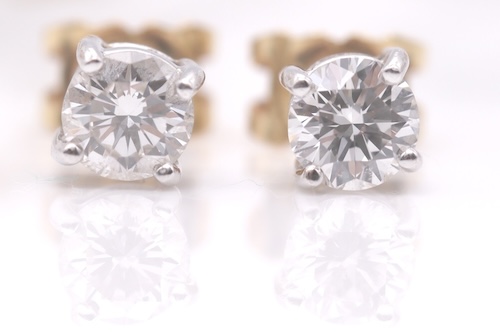By Victoria Stockwell
We all like sparkle, particularly at this time of year and with my attraction to all things shiny my tastes are akin to a magpie, so naturally I want the biggest, brightest, sparkliest thing I can find. This, combined with my interest in contemporary jewellery, has meant I have always gravitated towards the sparkliest diamond I can get: the classic round brilliant diamond cut…however, I am beginning to be enlightened by the antique jewellery specialist Clare Blatherwick as to the beauty and joy of Old European-cut diamonds. They each have distinctive characteristics, so lets delve into the fascinating journey of these diamond cuts and explore the unique allure each brings to the table. We have also posted a short video on some of our social media platforms of an interesting comparison between a beautiful pair of Old European cut diamond stud earrings and a pair of modern round brilliant cut diamond stud earrings.

History: Old European cut diamonds were crafted during a time when diamond cutting was more of an art than a science. Highly skilled artisans cut these stones by hand, using simple tools and often in candlelight. The craftmanship of that era, with its focus on maximising carat weight rather than optical precision, gives these diamonds a romantic allure that captivates many collectors today. In contrast the modern round brilliant cut was created in 1919 in by Marcel Tollowsky when he was studying mathematics and engineering at the University of London. His doctoral thesis was titled Diamond Design: ‘A study of the Reflection and Refraction of Light in a Diamonds’ and was the innovation of the ‘ideal’ cut.
Different Facet Patterns: Old Cut diamonds, whether Old European-cut or the earlier Old Mine-cuts have larger facets and a flat polished area at the back point of the diamond called the ‘culet’. However, these diamonds come into their own from a craftmanship perspective, every cut and every diamond will be different as it depends on the artisans cutting style, much like the way two written words can differ in look complexly according to the handwriting style. The sparkle between the two diamond cuts is quite different, the old cut diamond has a romantic soft glow when seen in the evening and looks at it best in candlelight, whereas the modern round brilliant cut has been engineered to maximize brilliance and sparkle in various lighting conditions with its precise 57 facets. Interestingly there can be an additional facet sometimes but it can be an indicator of a poorly cut diamond as ideally all the facets should culminate in perfect alignment at the point of the diamonds, sometimes if this is not the case it can be levelled out with the addition of the culet.
Shapes and Proportions: These differ between the two cuts and can help explain the way the light behaves differently inside the gemstone. The old European-cuts have unique characteristics such as smaller tables and higher crowns than their modern counterpart. In the ideal cut there are precise proportions and acceptable parameters of table size, crown height and pavilion depth that will give the maximum brilliance. It helps diamonds do what they do best – sparkle.
Fire and scintillation: In old cuts you can see warm colourful flashes of fire that will have a unique play of light. Modern round brilliant cuts are characterised by breathtaking scintillation and vivid, white light reflections.
Popularity and Rarity: There has been a resurgence of interest in old cuts for those who love vintage and antique jewellery, however old-cuts of diamonds are harder to find. There was a fashion for some time to have them repolished into ideal cuts, so to find, for example, a pair of earrings can be especially challenging. To find two stones that match in colour, clarity, shape is rare indeed. The modern round brilliant cut has a timeless appeal and is now the most popular cut of diamond in the world. Think of an engagement ring and what comes to mind? A round brilliant-cut solitaire of course!
As we compare old cut-diamonds and modern round brilliant-cut diamonds, it becomes evident that each has its own distinctive charm. Whether drawn to the romantic allure of history or captivated by the dazzling precision of modern cuts, diamond enthusiasts (i.e. magpies like me!) find themselves immersed in a world where the past and present coalesce in breathtaking brilliance.

.JPG)